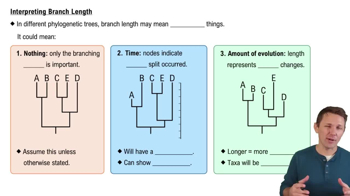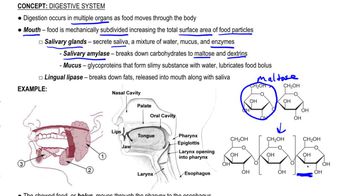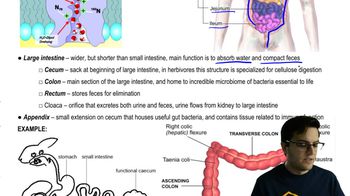Table of contents
- 1. Introduction to Biology2h 42m
- 2. Chemistry3h 40m
- 3. Water1h 26m
- 4. Biomolecules2h 23m
- 5. Cell Components2h 26m
- 6. The Membrane2h 31m
- 7. Energy and Metabolism2h 0m
- 8. Respiration2h 40m
- 9. Photosynthesis2h 49m
- 10. Cell Signaling59m
- 11. Cell Division2h 47m
- 12. Meiosis2h 0m
- 13. Mendelian Genetics4h 44m
- Introduction to Mendel's Experiments7m
- Genotype vs. Phenotype17m
- Punnett Squares13m
- Mendel's Experiments26m
- Mendel's Laws18m
- Monohybrid Crosses19m
- Test Crosses14m
- Dihybrid Crosses20m
- Punnett Square Probability26m
- Incomplete Dominance vs. Codominance20m
- Epistasis7m
- Non-Mendelian Genetics12m
- Pedigrees6m
- Autosomal Inheritance21m
- Sex-Linked Inheritance43m
- X-Inactivation9m
- 14. DNA Synthesis2h 27m
- 15. Gene Expression3h 20m
- 16. Regulation of Expression3h 31m
- Introduction to Regulation of Gene Expression13m
- Prokaryotic Gene Regulation via Operons27m
- The Lac Operon21m
- Glucose's Impact on Lac Operon25m
- The Trp Operon20m
- Review of the Lac Operon & Trp Operon11m
- Introduction to Eukaryotic Gene Regulation9m
- Eukaryotic Chromatin Modifications16m
- Eukaryotic Transcriptional Control22m
- Eukaryotic Post-Transcriptional Regulation28m
- Eukaryotic Post-Translational Regulation13m
- 17. Viruses37m
- 18. Biotechnology2h 58m
- 19. Genomics17m
- 20. Development1h 5m
- 21. Evolution3h 1m
- 22. Evolution of Populations3h 52m
- 23. Speciation1h 37m
- 24. History of Life on Earth2h 6m
- 25. Phylogeny2h 31m
- 26. Prokaryotes4h 59m
- 27. Protists1h 12m
- 28. Plants1h 22m
- 29. Fungi36m
- 30. Overview of Animals34m
- 31. Invertebrates1h 2m
- 32. Vertebrates50m
- 33. Plant Anatomy1h 3m
- 34. Vascular Plant Transport1h 2m
- 35. Soil37m
- 36. Plant Reproduction47m
- 37. Plant Sensation and Response1h 9m
- 38. Animal Form and Function1h 19m
- 39. Digestive System1h 10m
- 40. Circulatory System1h 57m
- 41. Immune System1h 12m
- 42. Osmoregulation and Excretion50m
- 43. Endocrine System1h 4m
- 44. Animal Reproduction1h 2m
- 45. Nervous System1h 55m
- 46. Sensory Systems46m
- 47. Muscle Systems23m
- 48. Ecology3h 11m
- Introduction to Ecology20m
- Biogeography14m
- Earth's Climate Patterns50m
- Introduction to Terrestrial Biomes10m
- Terrestrial Biomes: Near Equator13m
- Terrestrial Biomes: Temperate Regions10m
- Terrestrial Biomes: Northern Regions15m
- Introduction to Aquatic Biomes27m
- Freshwater Aquatic Biomes14m
- Marine Aquatic Biomes13m
- 49. Animal Behavior28m
- 50. Population Ecology3h 41m
- Introduction to Population Ecology28m
- Population Sampling Methods23m
- Life History12m
- Population Demography17m
- Factors Limiting Population Growth14m
- Introduction to Population Growth Models22m
- Linear Population Growth6m
- Exponential Population Growth29m
- Logistic Population Growth32m
- r/K Selection10m
- The Human Population22m
- 51. Community Ecology2h 46m
- Introduction to Community Ecology2m
- Introduction to Community Interactions9m
- Community Interactions: Competition (-/-)38m
- Community Interactions: Exploitation (+/-)23m
- Community Interactions: Mutualism (+/+) & Commensalism (+/0)9m
- Community Structure35m
- Community Dynamics26m
- Geographic Impact on Communities21m
- 52. Ecosystems2h 36m
- 53. Conservation Biology24m
39. Digestive System
Digestion
Problem 14c`
Textbook Question
Minnows are mainly carnivorous, eating insects and other small animals. However, herbivory has evolved independently in minnows several times.
What changes in digestive structure and function are associated with the evolution of herbivory?
Suggest a function of the difference in relative gut lengths of herbivorous and carnivorous minnows.
 Verified step by step guidance
Verified step by step guidance1
Understand the dietary needs of herbivorous minnows: Herbivorous minnows consume plant material, which is generally harder to digest than animal matter due to the presence of cellulose and other complex carbohydrates.
Identify changes in digestive structure: Herbivorous minnows may develop longer intestines or specialized structures like a cecum to increase the surface area for digestion and absorption, allowing more time for the breakdown of plant material.
Consider the role of gut microbiota: Herbivorous minnows might have a more diverse or specialized gut microbiota that aids in the breakdown of cellulose and other plant components, facilitating digestion.
Compare gut lengths: Herbivorous minnows typically have longer guts compared to carnivorous minnows. This increased length allows for extended digestion time and greater absorption of nutrients from plant material.
Suggest a function of gut length differences: The longer gut in herbivorous minnows may function to maximize nutrient extraction from plant material, compensating for the lower energy density and digestibility compared to animal-based diets.
 Verified video answer for a similar problem:
Verified video answer for a similar problem:This video solution was recommended by our tutors as helpful for the problem above
Video duration:
59sPlay a video:
Was this helpful?
Key Concepts
Here are the essential concepts you must grasp in order to answer the question correctly.
Digestive Structure Adaptations
Herbivorous minnows have evolved specific digestive structures to efficiently process plant material, which is harder to digest than animal matter. These adaptations may include elongated intestines to increase the surface area for nutrient absorption and specialized stomachs or gut regions for fermenting plant material, allowing for the breakdown of cellulose and other complex carbohydrates.
Recommended video:
Guided course

Digestion and Digestive Tracts
Digestive Function Changes
The evolution of herbivory in minnows involves changes in digestive enzyme production and microbial symbiosis. Herbivorous minnows may produce more cellulase and other enzymes to break down plant cell walls, and they often rely on symbiotic gut bacteria to aid in fermentation and digestion, enhancing their ability to extract nutrients from plant-based diets.
Recommended video:
Guided course

Digestion and Digestive Tracts
Relative Gut Length Differences
Herbivorous minnows typically have longer guts compared to carnivorous ones, which is crucial for maximizing nutrient absorption from plant material. The increased gut length allows for a prolonged digestion process, providing more time for enzymatic action and microbial fermentation, which are necessary to break down complex plant compounds and extract essential nutrients.
Recommended video:

Interpreting Branch Length
Related Videos
Related Practice















![Anatomy and Physiology of the Large Intestine [Colon]](https://img.youtube.com/vi/F4W2DLIKXww/mqdefault.jpg)




![IGCSE BIOLOGY REVISION - [Syllabus 7.5] Absorption](https://img.youtube.com/vi/TEOB94oBZN4/mqdefault.jpg)


























